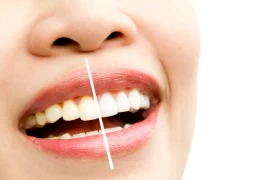
Aesthetic Fillings in Dentistry
- Aesthetic Fillings in Dentistry
- The Importance of Aesthetic Filling Applications
- Types of Aesthetic Fillings
- How is the Aesthetic Filling Procedure Performed?
Aesthetic filling procedures hold a significant place in modern dentistry, aiming to enhance patients' smiles and beautify their appearance. This method is employed to fill gaps in teeth, correct color discrepancies, and maintain the natural look of teeth. The positive effects of aesthetic filling procedures on dental health and overall quality of life are undeniable.
What is Aesthetic Filling? Aesthetic fillings are materials used to fill gaps, repair fractured or decayed teeth, address color discrepancies, and preserve the natural structure of teeth. These fillings are made from composite resins that can be customized to match the tooth color. Applied to match the tooth's shape, these fillings ensure that teeth appear aesthetically pleasing.
The Importance of Aesthetic Filling Applications
- Smile Aesthetics: A smile plays a crucial role in a person's appearance. Gaps, stains, or color discrepancies in teeth can negatively affect a smile. Aesthetic filling procedures address these issues, enabling patients to achieve a more beautiful smile.
- Natural Appearance: Aesthetic filling materials can be matched to the tooth color and are used to maintain a natural appearance. When applied to the tooth, the filling material seamlessly blends with the tooth surface, remaining unnoticed.
- Easy and Quick Application: Aesthetic filling procedures are usually completed within a short timeframe. Dentists ensure quick results by selecting appropriate materials and applying the correct techniques.
- Minimal Invasiveness: Aesthetic filling procedures are performed with a minimal invasive approach to preserve the natural tooth structure. Only a small amount of material is removed from the tooth surface, avoiding harm to tooth health.
- Various Application Areas: Aesthetic fillings can be used to repair cavities, correct broken or worn teeth, fill gaps, and remove stains. These versatile applications cater to both aesthetic and functional needs of patients.

Types of Aesthetic Fillings
The types of aesthetic fillings vary based on different needs and application areas. Here are some common types:
- Composite Fillings: Composite fillings are made from customizable materials that resemble tooth color. Dentists choose color and shape options according to the patient's tooth structure. Once applied to the tooth surface, these fillings are cured with a special light and shaped accordingly. Composite fillings are frequently used for aesthetic enhancements and minor restorations.
- Ceramic Fillings (Porcelain Fillings): Ceramic fillings are made from materials that closely resemble natural tooth structure. Specially prepared ceramic materials are produced in a laboratory and then applied to the tooth. The advantage of ceramic fillings is their durability and ability to match teeth in terms of color and texture.
- Veneers: Veneers are thin porcelain layers applied to the front surface of teeth. They can be customized in terms of color and shape. Veneers are used to address color discrepancies, repair broken teeth, remove stains, and improve the aesthetic appearance of teeth.
- Porcelain-Fused-to-Metal (PFM) Crowns: PFM crowns consist of a combination of ceramic and metal alloy. While ceramic is applied to the front surface of the tooth, metal alloy is used on the backside. These crowns aim to combine aesthetics and durability.
- All-Porcelain Crowns: All-porcelain crowns cover the entire tooth and provide aesthetic results with color and texture resembling natural teeth. They are often preferred for front teeth.
- Gold Fillings: Gold fillings are made from gold alloy. They can be used to address color discrepancies or for teeth located at the back of the mouth. Gold fillings are durable, but they might be less preferred by patients with aesthetic concerns.
- Acrylic Fillings: Acrylic fillings are temporary fillings. They help protect the tooth, especially during the treatment process, until a more permanent treatment plan is established.
The selection of aesthetic filling types depends on the patient's needs and the dentist's recommendations. Dentists evaluate patients' aesthetic and health requirements to determine the most suitable filling type and create a treatment plan.
How is the Aesthetic Filling Procedure Performed?
- Examination and Planning: The initial step involves evaluating the patient's dental structure and determining the appropriate filling type. A plan is created based on the patient's desires and the dentist's recommendations.
- Preparation: The tooth surface is cleaned with a special solution, and the area for filling is prepared.
- Filling Application: The selected composite resin material, matching the chosen color, is applied to the tooth to match its shape. The dentist places the material in layers and cures each layer with a specific light.
- Shaping and Polishing: After the material is applied, the dentist shapes it to achieve an aesthetic result. Finally, the filling surface is smoothed and polished to enhance its shine.
In conclusion, aesthetic filling procedures are important treatments in dentistry that provide both aesthetic and functional improvements. Through these procedures, patients achieve enhanced smiles while preserving dental health and aesthetics. Dentists plan aesthetic filling applications according to patients' needs, offering them a more attractive and healthy smile.






